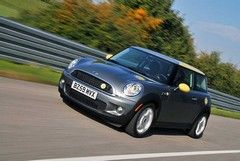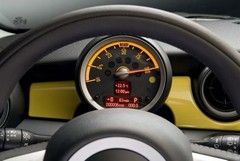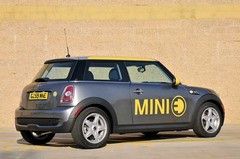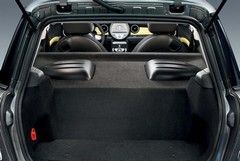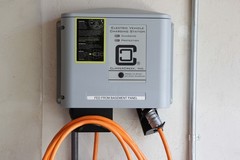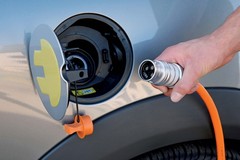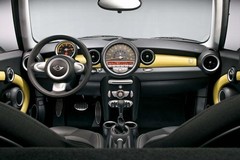Driven: MINI E
PH's Simon Mellins drives the electric MINI that BMW doesn't want to make
It was never going to be that easy to convince a room full of journalists to get that excited about a new car, when in the same breath you tell them unequivocally that you’re not going to produce it.
The MINI E, BMW’s first 100% electric, zero emissions car, is purely an exercise - but as exercises go, this is a pretty intense workout. 600 MINI E's have been built at MINI's Oxfordshire plant, to be used in field trials in various places around the world. In the UK they’ve chosen an area in the south west of England and the idea, we were told, is to get feedback from the users and the cars themselves (via data logging boxes) in order to help BMW's engineers develop the technology and packaging for a future mass-production electric city car.
From the outside, the E looks much like any other MINI. A bespoke paint scheme and a serial number by the side repeaters are the only real visual clues to what lies beneath. Well, that and the 'MINI E' stickers all over it.
But stepping closer other details become apparent. The rear bench has vanished for one, and in its place sits an enormous and neatly-carpeted vented hump containing the lithium-ion battery pack. The dashboard is also different; though the dials seem very familiar at first, you soon notice that the rev counter needle now points to the percentage of battery capacity remaining, and other gauges keep you informed about power consumption et al.
The downright bizarre sensation of pulling away in a single-gear electric car is something to be experienced. That unshakable instinct that at some point the revs should be coming down as a higher gear is engaged is - well - pretty unshakable, to me at least, but the noise is quite exciting. Quiet but far from silent, a pleasant rising whine accompanies the less pleasant roar of hard eco-tyres as the car gathers speed.
The electric engine produces 150kw, equivalent to 201bhp and 162 lb ft of torque, and 0-60 is consumed in a perfectly respectable 8.5 seconds. The slight delay off the line as engine speed builds is soon subsumed by a wave of satisfying torque, and the MINI feels like a tiny high-speed train. Unfortunately, that 'locomotive' feeling persists as you enter a corner.
Lugging those huge batteries around means that the unladen weight of the car is a hefty 1456kg - a full 260kg heavier than a standard Cooper S – and you can certainly feel it. The standard MINI's light-footed agility has all but disappeared completely, and though the superb weighting of the electric power steering survives, here it has rather less bearing on where you’re actually going.
The stiffened-suspension doesn’t really help to mask the significant momentum gathering through a bend, and the DSC and EBD are extremely eager to cut in. The mere suggestion of a tight corner had computers locking individual wheels and easing the gas off, tyres scrubbing hard and wailing in complaint.
As is becoming standard for electric cars, the E uses regenerative braking to turn excess kinetic energy (i.e. overrun) back into juice for the battery, theoretically extending the car's range by up 20%. But the effect is more than ordinary coasting - it'll pull up to 0.3g as you decelerate - I barely touched the footbrake in 35 miles of varied test driving. Though the ecological benefits are hard to deny, it was very hard to get used to, and made for some rather jerky progress at first, especially when I dared to lift off mid-corner. At that particular point, my passenger was as unimpressed with the 'regenerative brakes' as he was with my driving...
Sadly, even regenerative braking couldn't help the battery consumption in the end, which on my not overly-aggressive 35-mile drive went down from 100% to a mere 42%. Stated 'real world' range is 100-120 miles, but even this seems a tad optimistic.
Despite all this, the drive was for the most part pretty impressive. Considering the restraints of battery technology and associated weight and range issues, this is still a very usable car. The seamless and tractable power delivery, clever if counter-intuitive regenerative braking and a slick overall feel mean there is cause for optimism here, even if there is plenty of room for improvement.
MINI E project leader Emma Lowndes explained some of the reasons why the car is not scheduled for mass production. "The packaging just isn't right, the MINI wasn't designed to be an electric car", she explained.
"Also, our electric car really needs to have four seats".
She confirmed that the BMW 'Megacity', planned for around 2015, will have four seats, as well as the benefit of the MINI E testers' experiences, so expectations are high.
For now the technology isn't quite there. Apart from the dynamic and practical problems, there’s also the unspecified build cost of the car that BMW are being tight-lipped about. Nevertheless, the MINI E is certainly a step toward usable every day electric personal transport, and the drive is certainly not dull.
Talking about the future of BMW more widely, new head of corporate communications and ex-engineer Wieland Bruch assured me that an engaging drive is still high up in their priority list: "We will not let our cars' performance and handling suffer just to get more miles per gallon", he said with emphasis.
Ultimately the MINI E is a research project. The 20 members of the public who'll be running them for the next six months will be giving constant feedback to BMW on how they're finding living with the cars, and each will pay £330 per month for the privilege (though that does include tax, insurance and maintenance). As part of the deal, Southern Electric will fit a 32 Amp charging point in their home, from which the car will apparently charge fully in just four and a half hours, at a cost of around £1.50 during off-peak hours (£4.00 peak). Using an adaptor, a standard 13 Amp domestic plug will charge it in 10 hours should you find yourself stranded – a distinct possibility if my drive was anything to go by.
Another 20 tester slots will be becoming available in the Spring, so if you really want to help develop the cars of the future in a hands-on way then keep an eye on the MINI E microsite.
Gassing Station | General Gassing | Top of Page | What's New | My Stuff

